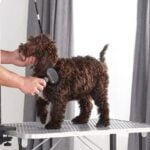Table of Contents
Excessive chewing is a common issue that many dog owners face. While chewing is a natural behavior for dogs, it can become problematic when they chew on everything in sight. This guide provides effective techniques on how to stop a dog from chewing everything, helping you protect your belongings and ensure your dog’s safety. Here are ten proven methods to manage and redirect your dog’s chewing behavior.

1. Provide Appropriate Chew Toys
Offering suitable chew toys is essential for redirecting your dog’s chewing behavior:
- Variety: Provide a variety of chew toys to keep your dog interested.
- Durability: Choose durable toys that can withstand your dog’s chewing.
- Size: Select toys that are appropriate for your dog’s size and chewing strength.
Appropriate chew toys help satisfy your dog’s natural chewing instincts and keep them engaged.
2. Exercise and Mental Stimulation
A well-exercised and mentally stimulated dog is less likely to engage in destructive chewing:
- Daily Walks: Ensure your dog gets plenty of physical exercise through daily walks and playtime.
- Interactive Toys: Use puzzle toys and treat-dispensing toys to challenge your dog mentally.
- Training Sessions: Incorporate regular training sessions to keep your dog’s mind active.
Exercise and mental stimulation reduce boredom and anxiety, which are common causes of excessive chewing.
3. Use Taste Deterrents
Taste deterrents can discourage your dog from chewing on inappropriate items:
- Bitter Sprays: Apply bitter-tasting sprays to furniture and other items your dog chews on.
- Commercial Products: Use commercial taste deterrents designed for dogs.
- Homemade Solutions: Make a homemade deterrent using vinegar or lemon juice diluted with water.
Taste deterrents make items less appealing to chew, helping to redirect your dog’s behavior.
4. Supervise and Redirect
Supervision and redirection are key to managing your dog’s chewing habits:
- Close Monitoring: Supervise your dog closely, especially during their early training stages.
- Immediate Redirection: When you catch your dog chewing on something inappropriate, immediately redirect them to a suitable chew toy.
- Positive Reinforcement: Praise and reward your dog when they chew on appropriate items.
Supervising and redirecting helps teach your dog which items are acceptable to chew.
5. Create a Safe Space
Providing a safe space can help manage your dog’s chewing behavior when you’re not around:
- Crate Training: Use a crate to confine your dog when you can’t supervise them. Ensure the crate has appropriate chew toys.
- Pet Gates: Use pet gates to limit access to rooms with items your dog might chew.
- Safe Area: Designate a safe area in your home where your dog can stay when unsupervised.
Creating a safe space helps prevent access to items that are off-limits and reduces opportunities for destructive chewing.
6. Address Underlying Issues
Chewing can be a sign of underlying issues such as anxiety or dental problems:
- Separation Anxiety: If your dog chews excessively when left alone, they may have separation anxiety. Consider behavioral training or consult a veterinarian.
- Dental Health: Ensure your dog’s teeth are healthy. Dental problems can lead to excessive chewing.
- Stress: Identify and address sources of stress in your dog’s environment.
Addressing underlying issues helps reduce the motivation for destructive chewing.
7. Consistent Training and Commands
Teaching your dog commands and maintaining consistency is crucial for managing chewing behavior:
- Leave It: Train your dog to respond to the “leave it” command to stop them from chewing on inappropriate items.
- Drop It: Use the “drop it” command to get your dog to release items they shouldn’t be chewing.
- Consistency: Be consistent with commands and training to reinforce appropriate behavior.
Consistent training helps your dog understand and follow the rules, reducing inappropriate chewing.
8. Use Chew-Resistant Materials
Protect your belongings by using chew-resistant materials and products:
- Furniture Covers: Use chew-resistant covers on furniture.
- Cable Protectors: Cover electrical cords with chew-resistant protectors.
- Heavy-Duty Rugs: Use durable, chew-resistant rugs in areas where your dog spends time.
Chew-resistant materials help protect your belongings from damage while you work on training.
9. Gradual Desensitization
If your dog chews due to anxiety or stress, gradual desensitization can help:
- Short Absences: Start with short absences and gradually increase the time you’re away.
- Calm Exits and Returns: Make exits and returns low-key to reduce anxiety.
- Comfort Items: Leave items with your scent to comfort your dog while you’re away.
Gradual desensitization helps reduce anxiety-related chewing behaviors.
10. Seek Professional Help
If your dog’s chewing behavior persists despite your efforts, seek professional help:
- Veterinarian: Consult a vet to rule out medical issues causing excessive chewing.
- Professional Trainer: Work with a certified dog trainer to address behavioral issues.
- Animal Behaviorist: An animal behaviorist can provide specialized guidance and training techniques.
Professional help can provide tailored solutions to effectively manage your dog’s chewing behavior.
Conclusion on How to Stop a Dog from Chewing Everything
Managing and redirecting your dog’s chewing behavior requires patience, consistency, and the right approach. By following these techniques on how to stop a dog from chewing everything, you can protect your belongings and ensure your dog’s safety. Provide appropriate chew toys, exercise and mental stimulation, use taste deterrents, supervise and redirect, create a safe space, address underlying issues, maintain consistent training, use chew-resistant materials, practice gradual desensitization, and seek professional help if needed. For more information on managing dog behavior, visit the ASPCA and AKC.
FAQs on How to Stop a Dog from Chewing Everything
Why does my dog chew on everything?
Dogs chew for various reasons, including teething, boredom, anxiety, and exploring their environment. Identifying the cause helps address the behavior.
How can I prevent my dog from chewing furniture?
Provide appropriate chew toys, use taste deterrents on furniture, supervise and redirect your dog, and use chew-resistant furniture covers.
Are there specific toys that can help with chewing?
Yes, durable chew toys, puzzle toys, and treat-dispensing toys are excellent for keeping your dog engaged and satisfying their chewing instincts.
What should I do if my dog chews on something dangerous?
Immediately remove the item from your dog’s mouth, check for any injuries, and consult a veterinarian if necessary. Ensure dangerous items are kept out of reach.
Can training commands help reduce chewing?
Yes, teaching commands like “leave it” and “drop it” can help manage and redirect your dog’s chewing behavior effectively.
When should I seek professional help for my dog’s chewing behavior?
If your dog’s chewing behavior persists despite your efforts, consult a veterinarian, professional dog trainer, or animal behaviorist for tailored solutions.











